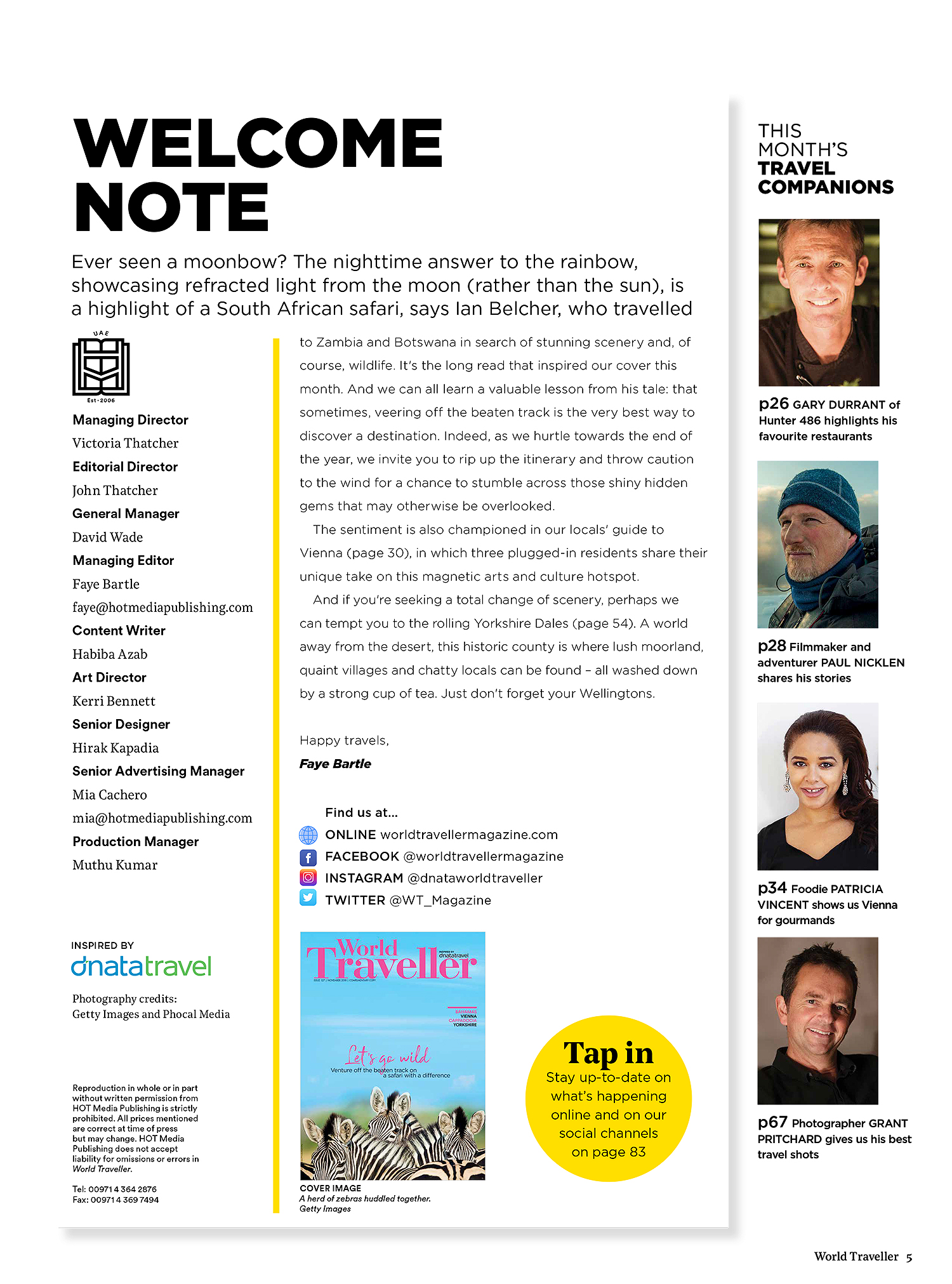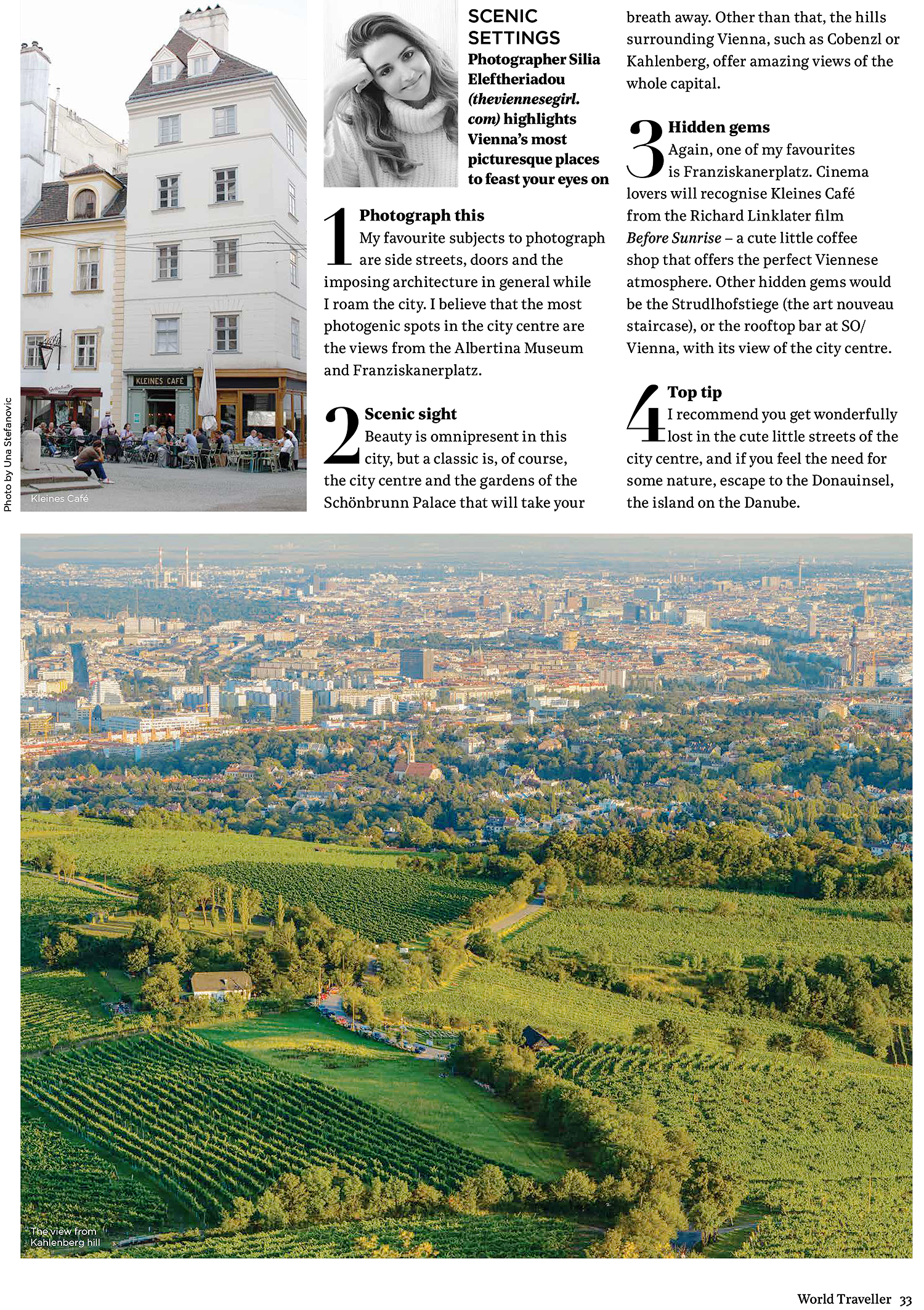A couple of days ago I've received, with a lot of enthusiasm, the November issue of World Traveller magazine, featuring Vienna, for which I was interviewed at the recommendation of Silia Eleftheriadou, the lovely photographer and blogger behind theviennesegirl.com.
World Traveller magazine was launched in 2005 and is part of HOT Media Publishing. It is the Middle East’s biggest and best source of travel inspiration, it enjoys unique, independently audited distribution to the region's most frequent travelers, including those in Saudi Arabia. It focuses on luxury travel, with tips, holiday ideas and in-depth destination features written for those with a sense of adventure.
Four creative professionals were selected to contribute to the ‘Locals’ guide…’ feature, designed to highlight must-try Vienna experiences: Silia Eleftheriadou, Jelena Fiala, Una Stefanovic and myself. I was attributed the foodie scene topic and offering all my recommendations, insights and confessions I found challenging, but nevertheless very pleasant.
Below, you can see my full interview, thank you for having me, Habiba Azab!
Tell us about the foodie scene in Vienna currently?
The foodie scene in Vienna got quite big recently, many blogs (e.g. https://www.esskultur.at/) and guides (e.g. https://www.diefruehstueckerinnen.at/ or http://www.a-list.at/wien/essen-trinken) are catering to this topic. The „Kaffeehauskultur“ is specific in Vienna which ideally translates into enjoying a coffee and dessert while reading the newspapers without any time pressure (an authentic version of „slow …“). I recently discovered ConFusion culinary school which is three minutes away from my studio. It's a fun, delicious and informative way to spend an evening learning how to prepare sushi, curry classics or steaks.
What characterizes the local cuisine and what influences it?
What we understand today as Viennese cuisine is clearly the result of Vienna having been the capital and center of a multicultural empire for hundreds of years. Local recipes mixed with the influences from people moving to the city, all bringing their own local cuisines with them, were making Vienna a culinary melting “pot” (Bohemian, Italian, Hungarian or Jewish traditions, just to name a few). In recent times, since the fall of the Iron Curtain, Vienna regained its position as a major European cultural and diplomatic center, attracting people from all over the world that directly and indirectly influence how the inhabitants of this city cook and enjoy their foods.
What authentic, local dishes should we taste?
As a vegetarian, when eating out, I find it pretty difficult to find a diverse offer that it is not just meat free but that is also not deep fried or flavored with “all seasoning” artificial blends. Some dishes that I love are the Steirische Kürbiscremesuppe (pumpkin cream soup served with a few drops of cold pumpkin seed oil), Käferbohnensalat (Scarlet runner bean salad), Steinpilz Ragoût (Porcini or Boletus mushrooms Ragoût) or the Kärntner Kasnudeln (Carinthian dumplings filled with fresh cheese and mint). When it comes to dessert, I will never refuse a Punschkrapferl (a delicious confectionery pastry with a fine rum flavor) or a Kardinalschnitte (Cardinal Slice) or the famous Sachertorte (a dark chocolate sponge cake with a thin layer of apricot jam).
What are the best homegrown restaurants and why do you rate them?
For Tafelspitz I would recommend Plachutta in Hietzing or Nußdorf (the one in the First District is overcrowded with tourists), Figlmüller for an authentic Wiener Schnitzel and Café Museum, Café Landtmann or Café Diglas for the classic „Kaffeehauskultur“ experience.
How do the locals enjoy mealtimes there – are there any foodie rituals or habits that stand out? Any etiquette we should be aware of?
There are no specific rituals, but usually you’re not getting seated when entering a restaurant, you freely chose from the available seats. When being served, courses are not mixed (e.g.: if someone orders a Vorspeise / a starter, the other person at the table will only get the main dish served after the other will be finished with the starter.) Also during a course feast, we don’t start to eat until everybody is served: meaning, only when everybody has the plate on the table for that specific course, then everybody starts to eat. Ideally, everybody gets served at the same time. Another interesting Viennese culinary tradition is Das Wiener Gabelfrühstück: a type of in-between meal, a bit like brunch, dedicated to the hard working people that have early working hours.
Where should we go for fine dining?
Vienna has an abundance of fine dining venues and although I mostly prefer the non touristic places, the nice ones are popular and therefore busy. I like Fuhrmann on Fuhrmannsgasse 9, 1080 Wien; Hansen on Wipplingerstraße 34, 1010 Vienna, Eckel on Sieveringer Str. 46, 1190 Vienna; Amador on Grinzinger Str. 86, 1190 Vienna or Mraz & Sohn on Wallensteinstraße 59, 1200 Vienna.
Any other iconic dining venues that aren't to be missed?
In my opinion, I consider these venues as iconic: Plachutta on Wollzeile 38, 1010 Vienna (I prefer the other Plachutta locations); Fabios on Tuchlauben 4, 1010 Vienna; Zum Schwarzen Kameel on Bognergasse 5, 1010 Vienna; Café Central on Herrengasse 14, 1010 Vienna or Café Landtmann on Universitätsring 4, 1010 Vienna. Die Wiener Würstelstände (the Viennese sausage & hot dogs street food stalls) are a popular spot among meat lovers on the go (Zum scharfen René in Schwarzenbergplatz or Hoher Markt stall in Hoher Markt). And the list can continue…
Anything else you would like to add about the foodie scene and ways to experience?
Since you now present the Autumn issue, I would say that the Christmas time is a nice occasion to experience some specific aspects of the Viennese eating traditions. The Christkindlmarkt / the Christmas markets are a nice place to taste little bites (roasted nuts, potatoes, sweet chestnuts etc.). The Heuriger / wineries or taverns in old, former rural regions such as Grinzing, Nußdorf, Salmannsdorf or Stammersdorf offer not only traditional dishes but homegrown wine. Heuriger means „this years wine“ and the most authentic version is called „Buschenschank“. You can recognize them by the bundle of green branches/twigs above the entrance (Busch means bush and Schank refers to a specific form of bar) - they only offer cold food and desserts besides their home grown wine. Traditionally you can hear musicians play Schrammelmusik, a Viennese folk music originated in the late nineteenth century.







